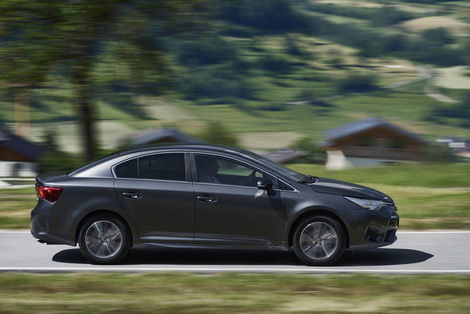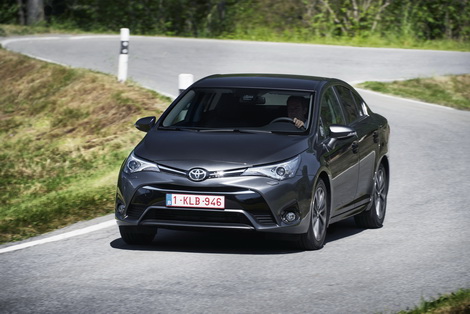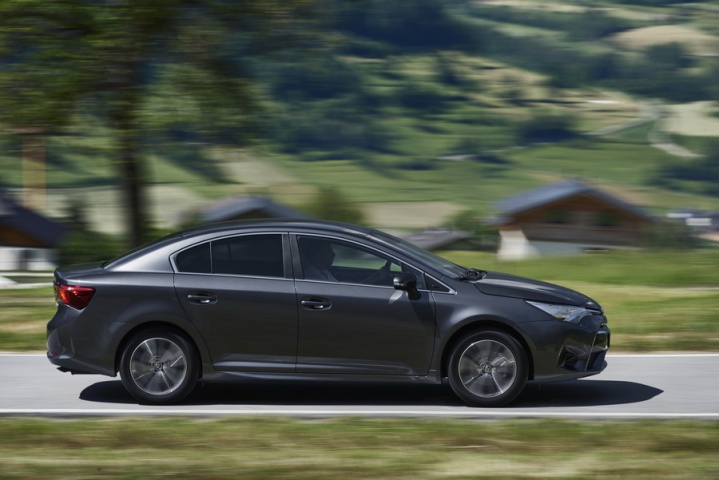Overall rating: 3.5/5
The significantly revamped Toyota Avensis looks better than ever and its standard inside has been has raised too. Its new engines promise greater performance overall, but the car stops short of toppling its rivals.


In the metal 4/5
Let's be honest; much of Toyota's styling over the last ten years hasn't been what you might call exciting. Giving credit where it's due though, this new Avensis does look good; in fact it's easily the best looking Avensis to date. From the front it has taken on a much sharper look, with sleeker headlight units that now converge towards a more pronounced badge in the centre.
The front bumper echoes the latest style from Toyota, one that we first saw on the heavily revised Yaris in 2014 - and in this case it works better. Even though the designers say that by pushing the fog lights to the extremities of the bumper it gains a broader look, we feel that the front end now appears slightly smaller and positively better than previous generations have. Along the sides there is less to talk about, with Toyota keeping it a relatively simple affair that is largely free from character and swage lines, though the sills get slight detail work. At the rear, sharper light units are bridged by a thin chrome bar and there's a shapelier bumper.

Just as significant is the interior and this is where you feel Toyota has done its best work. Both Luna and Sol specification cars get an eight-inch colour touchscreen in the centre console that make it one of the largest offerings in the sector. Here and across the rest of the dashboard area the quality of the materials used has been improved upon too. The multifunction steering wheel is perfectly sized and is tactile to hold, while the seats have been redesigned to offer greater support both in the base and in how they are bolstered. The rear remains largely the same in terms of space, with the flat floor making life more comfortable for the middle seat passenger. Boot space is a useful 509 litres and the rear seats can split 60:40 and be folded down to help accommodate longer items.
Driving it 3.5/5
Dynamically, Toyota had been playing catch up to its rivals and in a bid to improve on-road performance its engineers have added more support to the chassis to improve overall rigidity. From extra spot welds on the underbody to a stronger glue that holds the windscreen glass in place the job has been thorough. In-cabin noise levels have also been addressed with the inclusion of more sound insulating material beneath the car, under the bonnet and across the bulkhead. Even the air conditioning system has been muted through new air ducting. It's a shame then that the amount of wind noise at motorway speed around the door mirrors and glass seals either hasn't been addressed or has simply been highlighted by making so many other things quieter.

For its new 1.6-litre diesel engine Toyota turned to BMW. The turbocharged four-cylinder unit produces 112hp and an adequate 270Nm of torque. It's a good unit with useable power for most urban driving; that peak torque figure arrives at 1,750rpm meaning you'll never have to rev the engine all that much to get around in the lower gears. Out of town it performs well with a sixth gear that doesn't leave the engine speed too high when cruising although you will need to occasionally drop to fifth for faster overtaking. The manual gearbox doesn't feel quite as vague as before in its changes either, which is a welcome improvement. Toyota says the Avensis 1.6 will consume 4.2 litres/100km on the 17-inch wheels that feature as standard on mid-level Luna specification and we see no reason why that can't be easily achieved without a great deal of effort.
The Avensis rides well and through bends exhibits a good degree of body control. The suspension has been retuned to be softer but firms up further into its stroke. The steering is light enough around town but in corners can feel a touch too heavy and the self-centring is too strong for our liking. It doesn't have the same fluid feel on the road that you find in either the Ford Mondeo or Volkswagen Passat. The Avensis is a comfortable car to drive though; a combination of a well damped ride and supportive seats make longer journeys less taxing on the driver.

What you get for your money 3.5/5
Toyota sees itself as 'democratising safety' with its new specifications, as there's a lot of safety equipment as standard on the Luna and Sol grade model; however, offering them across the board would give the company greater justification of using that word. All cars will get the Pre-Collision System, which can mitigate against a rear-end collision at speeds of up to 80km/h. It won't totally prevent them but it will help reduce the speed of impact, and at sub-30km/h speeds is likely to prevent them depending on road and tyre conditions.
Luna grade is a €2,240 price walk from Aura and adds 17-inch alloy wheels, dual-zone air conditioning, that lovely eight-inch touchscreen system along with a 4.2-inch TFT screen nestled between the dashboard instruments, reversing camera and automatic headlights, as well as Alcantara upholstery inserts. Other safety systems include Road Sign Assist and Lane Departure Alert.
The range-topping Sol grade costs a further €2,300 and adds machine faced alloy wheels, leather seats, rear privacy glass and Smart Entry. One further thing worth mentioning is that the new 1.6-litre engine extends the service interval from 15,000- to 20,000 kilometres and, despite being a BMW engine, Toyota claims it will cost no more than a regular Toyota engine to service.

Summary
Toyota has done much to improve the Avensis both aesthetically and performance wise. While it's much better, we reckon it doesn't go far enough and feels like Toyota decided to bring its car up to par with its rivals rather than attempting to surpass them.















